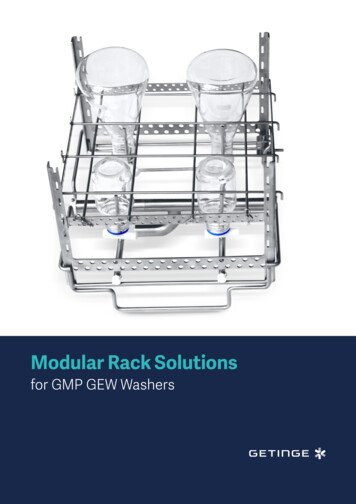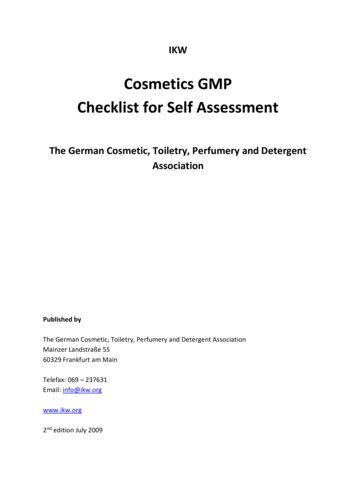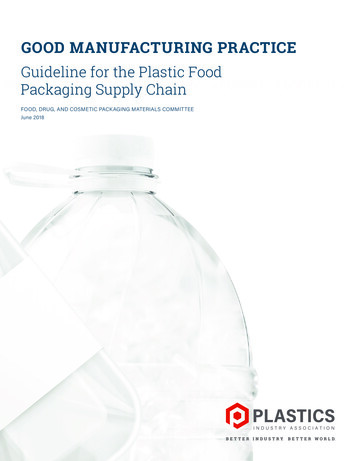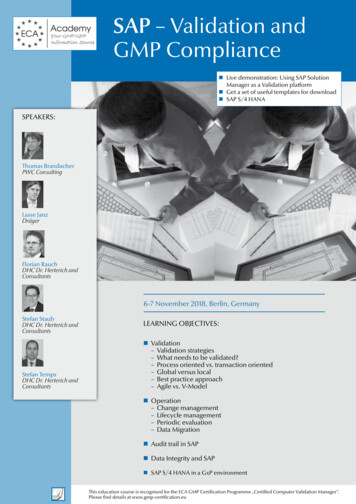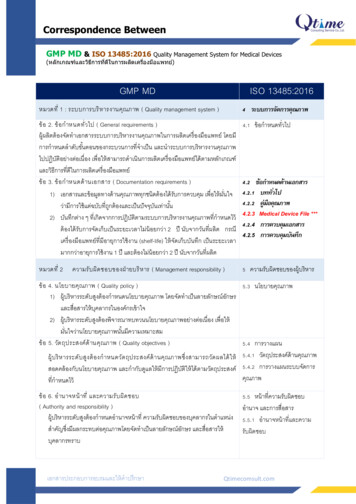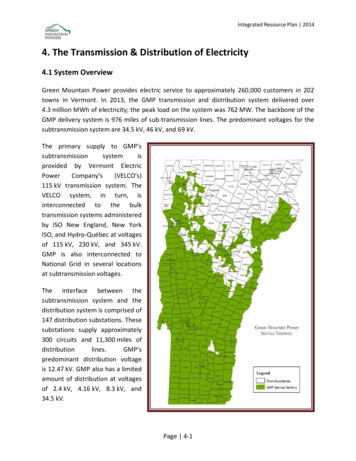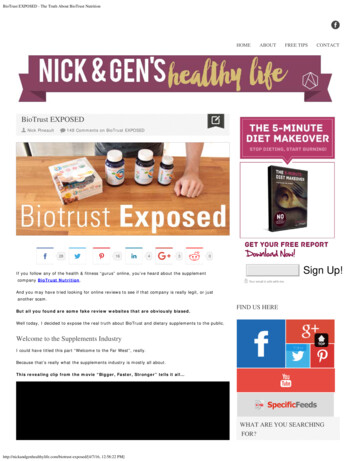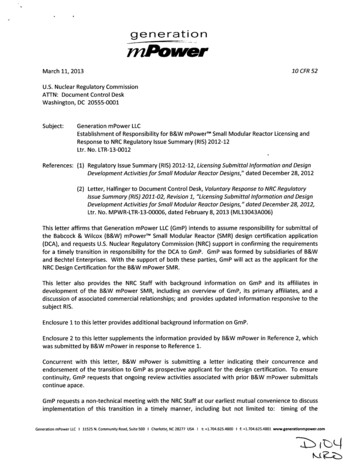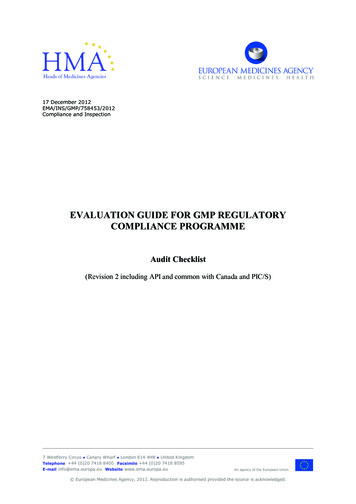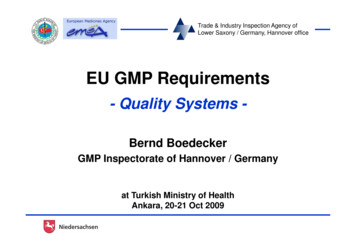
Transcription
Trade & Industry Inspection Agency ofLower Saxony / Germany, Hannover officeEU GMP Requirements- Quality Systems Bernd BoedeckerGMP Inspectorate of Hannover / Germanyat Turkish Ministry of HealthAnkara, 20-21 Oct 2009
Trade & Industry Inspection Agency ofLower Saxony / Germany, Hannover officecontact dataBernd BoedeckerStaatliches Gewerbeaufsichtsamt HannoverDezernat 74 (GMP Inspectorate)Am Listholze 74D-30177 Hannoverphone: 49 (0)511 / 9096-464fax : 49 (0)511 / 9096-199bernd.boedecker@gaa-h.niedersachsen.deTMH, Ankara, 20-21 Oct 2009Bernd Boedecker2
Trade & Industry Inspection Agency ofLower Saxony / Germany, Hannover officeBiodata of the speaker Name: Nationality: Education:Bernd BoedeckerGermanQualified pharmacistCertified expert for Pharmaceutical TechnologyGMP Inspector (since 2006) Current position: Further professionalbackground:Pharma industry (1984 - 2005)various R&D-based companiesmostly at interface Development vs. Production Special interests:Quality Risk Mgt, Quality by Design, ProcessValidation, Investigational Medicinal ProductsTMH, Ankara, 20-21 Oct 2009Bernd Boedecker3
Trade & Industry Inspection Agency ofLower Saxony / Germany, Hannover officeContents covered1.2.3.4.5.6.7.8.Quality ManagementQuality Risk ManagementChange ControlDeviation Management & CAPAComplaint & Recall HandlingProduct Quality ReviewOn-going Stability ProgrammeICH Q10 – Pharmaceutical Quality SystemTMH, Ankara, 20-21 Oct 2009Bernd Boedecker4
Trade & Industry Inspection Agency ofLower Saxony / Germany, Hannover officePreliminary note-subject matters of the presentations are many and fairly broad available time to present them is short many aspects presumably not really new to you Hence, what to do? focus on specific EU legislative basis 2nd focus on real-life (EU inspector‘s life ) interpretations (3rd focus on recent trends / upcoming changes) quite a large number of slides (as an aid for later use) live presentation of the slides not as detailed if questions related to details not answered in the discussion: feel invited to contact me at any time! (contact data see slide no. 2)TMH, Ankara, 20-21 Oct 2009Bernd Boedecker5
Trade & Industry Inspection Agency ofLower Saxony / Germany, Hannover office1. Quality ManagementTMH, Ankara, 20-21 Oct 2009Bernd Boedecker6
Trade & Industry Inspection Agency ofLower Saxony / Germany, Hannover officeLegal basis Commission Directive 2003/94/EC of 8 October 2003laying down the principles and guidelines of good manufacturingpractice in respect of products for human use and investigationalmedicinal products for human use Commission Directive 91/412/EEC of 23 July 1991laying down the principles and guidelines of good manufacturingpractice for veterinary medicinal products EudraLex Volume 4 – EU Guidelines to Good Manufacturing Practicefor Human and Veterinary Use (EC GMP ls/eudralex/eudralex en.htmTMH, Ankara, 20-21 Oct 2009Bernd Boedecker7
Trade & Industry Inspection Agency ofLower Saxony / Germany, Hannover officeDefinitions (1) Quality: (not defined in EU GMP Guidances) degree to which a set of inherent properties (of a product, system, orprocess) fulfills requirements [ISO 9000 / ICH Q9 and Q10] Pharmaceutical Quality Assurance: the total sum of the organised arrangements made with the object ofensuring that medicinal products are of the quality required for theirintended use(Directives 2003/94/EC art. 2 no. 5, and 91/412/EEC art. 2) Good Manufacturing Practice (GMP): the part of quality assurance which ensures that products areconsistently produced and controlled in accordance with the qualitystandards appropriate to their intended use(Directives 2003/94/EC art. 2 no. 6, and 91/412/EEC art. 2)TMH, Ankara, 20-21 Oct 2009Bernd Boedecker8
Trade & Industry Inspection Agency ofLower Saxony / Germany, Hannover officeDefinitions (2) Quality Management (QM): (not defined in EU GMP guidances) Sum of quality control, quality assurance, and quality improvement(?) Quality System Quality Management System: (not defined in EU GMP guidances) Instrument of the company management to ensure QM (?) System of Quality Assurance (QA): Incorporates Quality Control, GMP, and Quality Risk Management[EC GMP Guide Part I chap. 1 / principle]TMH, Ankara, 20-21 Oct 2009Bernd Boedecker9
Trade & Industry Inspection Agency ofLower Saxony / Germany, Hannover officeGMP and ISO standards GMPs developed in the late 1960s, ISO 9000 series in the 1990s Comment in the Introduction to the EC GMP Guide: CEN/ISO standards may be used at industry‘s discretion as atool for implementing a quality system CEN/ISO standards considered in the GMP Guidebut terminology not implemented It is recognised that there are other methods than thosedescribed in the Guide It is not intended to place any restraints upon [ ] new conceptswhich [ ] provide a level of Quality Assurance a least equivalent Recent evolution: ICH Q10 [ see separate section]TMH, Ankara, 20-21 Oct 2009Bernd Boedecker10
Trade & Industry Inspection Agency ofLower Saxony / Germany, Hannover officeQA/QM Principles Objectives [EC GMP Guide Part I chap. 1 / principle]: Product fit for intended use Compliance with Market Authorisation Patients not at risk due to inadequate safety, quality or efficacy (‚first time right‘) Responsibility and active participation of senior management All quality related activities defined and documented / recorded Responsibilities defined (in writing) Independent quality unit [EC GMP Guide Part II ICH Q7] Release of materials only after controls completed Evaluation of (unplanned) deviations and (intentional) changesTMH, Ankara, 20-21 Oct 2009Bernd Boedecker11
Trade & Industry Inspection Agency ofLower Saxony / Germany, Hannover officeGeneral Approaches toInspection of Systems Top-down Check of system structure and related internal procedures, e.g.:-workflows logical, feasible, and to the purpose?responsibilities adequately assigned?staff resources available? (number and qualification)life-cycle concept for documents?overall system design compliant with regulations? Spot checks- for compliance to the system description- for science-based and risk-oriented treatment of the individual case Bottom-up Start with a practical case out of a list of system applications TMH, Ankara, 20-21 Oct 2009Bernd Boedecker12
Trade & Industry Inspection Agency ofLower Saxony / Germany, Hannover officeInspection of QA systems –Typical Elements (1) Commitment of senior management to Quality Assurance(support QA objectives, provide resources, build structure, participation)QA organisation duties; adequate scope? defined? structure: adequate? Incl. interfaces to other depts / to Qualified Person? sufficiently staffed? (head-count and qualification) assigned authorities sufficient?Documentation system all quality-related areas covered? document hierarchy logical? document workflows acc. to life-cycle concept? up-to-dateness regularly checked?PDCA cycle followed? (plan – do – check – act)TMH, Ankara, 20-21 Oct 2009Bernd Boedecker13
Trade & Industry Inspection Agency ofLower Saxony / Germany, Hannover officeInspection of QA systems –Typical Elements (2) Subsequent areas covered by the QA system and adequately dealt with? Document management Change control [ separate section] Deviation mgt / CAPA [ separate section Quality risk mgt [ separate section] Staff training Appraisal of suppliers and third party service providers Qualification / validation Hygiene programmes and environmental monitoring Release of materials / premises / equipment for use, execution of IPCs Batch record review Complaints handling Self inspections Product quality review [ separate section] On-going stability programme [ separate section]TMH, Ankara, 20-21 Oct 2009Bernd Boedecker14
Trade & Industry Inspection Agency ofLower Saxony / Germany, Hannover office2. Quality Risk Management (QRM)TMH, Ankara, 20-21 Oct 2009Bernd Boedecker15
Trade & Industry Inspection Agency ofLower Saxony / Germany, Hannover officeWhat is Quality Risk Management? Quality Risk Management:‚a systematic process for the assessment, control, communication and review of risks tothe quality of the drug (medicinal) productacross the product lifecycle‘[Annex 20 to EC GMP Guide ICH Q9, section ‚Definitions‘] Risk:‚the combination of the probability of occurrence of harm and the severity of thatharm‘ [dtto.] Risk Management:‚systematic application of quality mgt policies, procedures and practices to the tasksof assessing, controlling, communicating and review of risks‘ [dtto.] Product Lifecycle:‚all phases in the life of the product from initial development through marketing untilthe product‘s discontinuation‘ [dtto.]TMH, Ankara, 20-21 Oct 2009Bernd Boedecker16
Trade & Industry Inspection Agency ofLower Saxony / Germany, Hannover officeElements of a Risk Mgt Process Risk assessment:‚a systematic process of organizing information to support a risk decisionto be made with a risk management process [ICH Q9 / Definitions] Risk control:‚actions implementing risk management decisions [dtto.] Risk communication:‚the sharing of information about risk and risk mgt between the decisionmaker and other stakeholders‘ [dtto.] Risk review:‚review or monitoring of outputs/results of the risk mgt process considering(if appropriate) new knowledge and experience about the risk [dtto.]TMH, Ankara, 20-21 Oct 2009Bernd Boedecker17
Trade & Industry Inspection Agency ofLower Saxony / Germany, Hannover officeFurther Useful Terms Risk identification – systematic use of information to identify potentialsources of harm (hazards) referring to the risk question or problemdescription [ICH Q9 / Definitions] Risk analysis – the estimation of the risk associated with the identifiedhazards [dtto.] Risk reduction – action taken to lessen the probability of occurrence andthe severity of that harm [dtto.] Risk acceptance – the decision to accept risk [dtto.] Stakeholder – any individual, group or organisation that can affect, beaffected by, or perceive itself to be affected by a risk [ ] Primarystakeholders are the patient, healthcare professional, regulatoryauthorities, and industry. [dtto.]TMH, Ankara, 20-21 Oct 2009Bernd Boedecker18
Trade & Industry Inspection Agency ofLower Saxony / Germany, Hannover officeICH Q9 on Quality Risk Management . was the trigger to incorporate QRM in EU GMP requirements is itself part of a broader initiative (ICH Q8/Q9/Q10) originally aiming at facilitation of innovation and global harmonisation ofregulatory requirements for innovative drugs and technologies is not just a means to improve quality standards is not a classical GMP guidance document neither relates only to GMP nor is merely an industry guidance has only in parts legally binding character in EU requires specific methodological knowledge(for both, implementation and surveillance) requires a somehow different approach by the GMP inspector!TMH, Ankara, 20-21 Oct 2009Bernd Boedecker19
Trade & Industry Inspection Agency ofLower Saxony / Germany, Hannover officeAddressees of ICH Q9 Pharma industry Development, manufacture / control, and distribution of drugs Regulatory authorities Granting of market authorisations (MAs) Approval of variations to MAs Supervisory authorities Granting of manufacturing / import authorisations GMP inspections Non-compliance / complaint / recall handlingTMH, Ankara, 20-21 Oct 2009Bernd Boedecker20
Trade & Industry Inspection Agency ofLower Saxony / Germany, Hannover officeObjectives of ICH Q9 Better and better informed risk decisions through systematic and science-based treatment of risks Enhanced predictability / uniformity of risk decisions Better documentation and transparency of risk decisions well-informed stakeholders Increase knowledge about risks Facilitate innovation and continuous improvement Effective use of resources, commensurate with level of risk forpatient safety Improve confidence between companies and authorities authorities amongst each otherTMH, Ankara, 20-21 Oct 2009Bernd Boedecker21
Trade & Industry Inspection Agency ofLower Saxony / Germany, Hannover officeContents of ICH Q9 Principles of Quality Risk Management Model of a risk management process(identification assessment control communication review) Proposals for applicable risk mgt methodsProposals for fields of application for QRMDefinitionsLiterature dfTMH, Ankara, 20-21 Oct 2009Bernd Boedecker22
Trade & Industry Inspection Agency ofLower Saxony / Germany, Hannover officeImplementation of QRM in the EU –a Brief History 2005: adoption of current ICH Q9 version by EU, US and JP since 2006: adaptation of EU regulatory guidances e.g. ICH Q8 ‚Note for Guidance on Pharm. Development‘ 2008: in EU implementation of ICH Q9 as a GMP standard principles in EC GMP Guide Part I chapters 1.5 and 1.6 options in Annex 20 to EC GMP Guide since 2008: integration into EC/EMEA ‚Compilation of CommunityProcedures on Inspections and Exchange of Information‘ (on-going) further implementations intended (e.g. GMP for APIs)TMH, Ankara, 20-21 Oct 2009Bernd Boedecker23
Trade & Industry Inspection Agency ofLower Saxony / Germany, Hannover officeIntroduction to EC GMP Guidewith respect to QRM GMP Part 1, Chapter 1 on Quality Management has been revised toinclude aspects of quality risk management within the quality systemframework. In future revisions of the guide the opportunity will be takento introduce QRM elements when appropriate. The new GMP Annex 20 [ ] provides guidance on a systematic approachto QRM leading to compliance with GMP and other quality requirements.It includes principles to be used and options for processes, methodsand tools which may be used when applying a formal QRM approach With its principles, methods and tools Annex 20 provides a systematicapproach which may be used to demonstrate such*) equivalence.*): equivalence of methods, technologies etc. not described in the Guidewith the principles of the GuideTMH, Ankara, 20-21 Oct 2009Bernd Boedecker24
Trade & Industry Inspection Agency ofLower Saxony / Germany, Hannover officeEC GMP Guide Part I Chap. I (1) Principle To achieve the quality objective reliably there must be acomprehensively designed and correctly implemented system ofQuality Assurance incorporating Good Manufacturing Practice,Quality Control, and Quality Risk Management.It should be fully documented and its effectiveness monitored. Allparts of the Quality System should be adequately resourced The basic concepts of Quality Assurance, Good ManufacturingPractice, Quality Control and Quality Risk Management are interrelated. TMH, Ankara, 20-21 Oct 2009Bernd Boedecker25
Trade & Industry Inspection Agency ofLower Saxony / Germany, Hannover officeEC GMP Guide Part I Chap. I (2) Quality Risk Management1.5 Quality risk management is a systematic process for theassessment, control, communication and review of risks to thequality of the medicinal product. It can be applied both proactivelyand retrospectively.1.6 The quality risk management should ensure that- the evaluation of risk to quality is based on scientificknowledge, experience with the process and ultimately linksto the protection of the patient- the level of effort, formality and documentation of the qualityrisk management process is commensurate with the levelof risk.Examples of the processes and applications of quality riskmanagement can be found inter alia in Annex 20.TMH, Ankara, 20-21 Oct 2009Bernd Boedecker26
Trade & Industry Inspection Agency ofLower Saxony / Germany, Hannover officeFields of Application of QRMin the GMP Area – Examples: (Product and process development)Change managementDeviation management & CAPASupplier and service provider qualification / auditingEquipment qualification, computer validation, maintenance programmesEnvironmental monitoring / hygiene programmesPrevention of cross-contaminationProcess validation / technology transferCleaning validationValidation / transfer of analytical methods (e.g. robustness testing)On-going stability monitoring programmeComplaints handlingTMH, Ankara, 20-21 Oct 2009Bernd Boedecker27
Trade & Industry Inspection Agency ofLower Saxony / Germany, Hannover officeQRM Methods and Tools – Examples Informal methods Flowcharts, checklists, fishbone diagrams, brainstorms, etc. Formal methods FME(C)A – Failure Modes (Criticality) & Effects Analysis FTA – Fault Tree Analysis HACCP – Hazard Analysis & Critical Control Points HAZOP – Hazard Operability Analysis (customised) Combination of different methods Supportive tools Statistical analyses, control charts, process capability, etc.TMH, Ankara, 20-21 Oct 2009Bernd Boedecker28
Trade & Industry Inspection Agency ofLower Saxony / Germany, Hannover officeInspection of QRM Systems Typical Elements Integration of QRM into the quality management system: areas of application of QRM sufficiently defined? responsibilities defined? sufficient qualification / training of personnel considered? adequate involvement of senior management envisaged? risk mgt procedures defined? application of general QA standards with respect to documentation? Risk mgt procedures adequate? workflow systematic? logical order? complete? patient safety oriented? commensurate with level of risk? Way of selecting methods and tools? Suitable degree of formality? Procedure for definition of risk acceptance criteria adequate? Resources sufficient to execute QRM?TMH, Ankara, 20-21 Oct 2009Bernd Boedecker29
Trade & Industry Inspection Agency ofLower Saxony / Germany, Hannover officeInspection of Individual Risk Cases Typical Elements Clear-cut definition of the risk question / problem?People involved qualified? Did all relevant stakeholders participate?Systematic approach applied? Selected methods / tools suitable?Risks adequately identified and analysed? e.g. all relevant data considered / generated?Risk acceptance criteria adequate for the case?Risk decision well-informed, science-based and comprehensible? e.g. reliability of data base considered? in compliance with pre-set acceptance criteria?Risk reduction measures realised? success reviewed?Documentation complete and traceable?Internal QRM and QM procedures adhered to?Level of effort and reaction time proportionate?TMH, Ankara, 20-21 Oct 2009Bernd Boedecker30
Trade & Industry Inspection Agency ofLower Saxony / Germany, Hannover office3. Change Control (CC)TMH, Ankara, 20-21 Oct 2009Bernd Boedecker31
Trade & Industry Inspection Agency ofLower Saxony / Germany, Hannover officeLegal basis of CC EC GMP Guide Part I (drug products) significant changes to the [manufacturing] process have to bevalidated [chapter 1.2 (ii) changes carried out to the processes or analytical methodshave to be reviewed regularly [chapter 1.4 (v), on PQR] no explicit requirement of a CC system( but inherent from the definition of quality assurance) Annex 15 to EC GMP Guide written procedures [no. 43] all changes treated formally, impact to be evaluated, need ofrevalidation to be determined [no. 44] EC GMP Guide Part II (active ingredients) a formal CC system should be implemented [section 13.]TMH, Ankara, 20-21 Oct 2009Bernd Boedecker32
Trade & Industry Inspection Agency ofLower Saxony / Germany, Hannover officePrinciples of Change Control Changes in general should be regarded as something positive No execution of changes subject to official consent prior to notification of regulatory and/or supervisory authority approval by competent authority (where approval is required) No execution of any proposed change without prior assessment ofpotential impact on product quality and / or patient safety! including changes having only indirect impact (e.g. computer software) Prior validation or any other testing, as required by the individualnature and extent of the change Formal procedure for proposal, assessment, definition ofaccompanying measures, approval and follow-up of each change Full documentation of each change control procedure After execution of a change, evaluation of its successTMH, Ankara, 20-21 Oct 2009Bernd Boedecker33
Trade & Industry Inspection Agency ofLower Saxony / Germany, Hannover officeReporting of Changes to Authorities related to manufacturing / import authorisation all changes outside scope of the authorisation all other siginificant changes – depending on national legislation(e.g. key staff, name / site of contract manufacturers or QC labs) Site Master File contents (where up-to-dateness is required) related to market authorisation according to Variation Regulation (1234/2008/EC as of Jan. 2010) or national equivalent related to aspect of the labelling or the package leaflet,if change not covered by SPC (Specification of Product Characteristics) related to wholesale distribution authorisationTMH, Ankara, 20-21 Oct 2009Bernd Boedecker34
Trade & Industry Inspection Agency ofLower Saxony / Germany, Hannover officeCase Examples Requring FormalCC Procedures Changes to: Starting materials (incl. specifications, suppliers) Product components (incl. labelling and packaging materials) Process equipment (incl. computer hard- and software) Process environment (facilities, media, support systems, ) Method of production Method of testing any other change that may affect product quality orreproducibility- e.g. cleaning procedures, transport conditions, TMH, Ankara, 20-21 Oct 2009Bernd Boedecker35
Trade & Industry Inspection Agency ofLower Saxony / Germany, Hannover officeSorts of Changes planned vs. unplanned ( deviations) [ see sep. section]major / minor (optional; enables variable level of effort / formality)may affect: official authorisations (marketing, manufacture, wholesale, ) internal quality system onlyas to areas concerned(site specific, corporate, involving 3rd parties)as to subjects / objects(personnel, facilities & equipment,materials / products)as to processes(e.g. purchasing, flow of materials, manufacture, cleaning, quality control,release, storage, distribution, complaints handling, )as to systems / programmes(QA, documentation, computers, monitoring, on-going stability, )TMH, Ankara, 20-21 Oct 2009Bernd Boedecker36
Trade & Industry Inspection Agency ofLower Saxony / Germany, Hannover officeTypical Triggers of CC procedures Proposals for preventive actions following occurred deviations,OOS/OOL/OOT/OOE results or ‚near accidents‘Audit / inspection findingsSourcing problemsPoor robustness of manufacturing processes or test methodsLacking regulatory or GMP complianceTightened product quality / safety requirementsTightened HSE requirementsNew drug regulationsEconomical considerations (e.g. material cost, productivity)Lacking efficiency of internal business processesUpgrades of technical environment (e.g. buildings, IT)Changes of product portfolio and volumesNew company strategies(e.g. missions, organisational, technology, quality mgt)TMH, Ankara, 20-21 Oct 2009Bernd Boedecker37
Trade & Industry Inspection Agency ofLower Saxony / Germany, Hannover officeInspection of CC Systems –Typical Elements (1) CC system integrated into overall QA system?(same Q‘s as for QRM system see previous slide no. 29) All potentially product quality affecting change proposals covered? incl. purchasing, distribution, transport, ? incl. QA system itself? incl. contracted out activities? incl. introduction of new products? [ risk of cross contamination?]Responsibilities defined / CC team composition suitable? incl. project manager / coordinator, task owners? incl. for categorisation of significance (if done)? incl. suitable involvement of Qualified Person? technical expertise from all relevant disciplines involved? QA and Regulatory Affairs departments involved?TMH, Ankara, 20-21 Oct 2009Bernd Boedecker38
Trade & Industry Inspection Agency ofLower Saxony / Germany, Hannover officeInspection of CC Systems –Typical Elements (2) CC procedure: incl. documentary capture of each CC case in a list? status control? (proposed / approved / implemented / reviewed) list complete for periodic review? incl. consideration of possible impact on other products? incl. check for need of notification / approval by authorities? incl. check for need of notification / approval by third parties? incl. check for need of re-qualification / re-validation? adequate use of quality risk management? [ see previous section] documentation of CC cases traceable / comprehensible? CC system part of self-inspections / audits at 3rd parties?TMH, Ankara, 20-21 Oct 2009Bernd Boedecker39
Trade & Industry Inspection Agency ofLower Saxony / Germany, Hannover officeNeed for Re-validationFollowing a Change May be required by regulatory authority in the course of approvalof a variation application[cf. NfG on Process Validation, Sept. 2001] GMP principles validation requirements are basically same for new andchanged processes [Annex 15] but prior knowledge could reduce scope of validation effort Rationale for non-necessity or reduced scope should be basedupon a risk analysisTMH, Ankara, 20-21 Oct 2009Bernd Boedecker40
Trade & Industry Inspection Agency ofLower Saxony / Germany, Hannover officeTypes of Changes Likely *)to Require Re-validation Physical properties of a raw materialStarting material manufacturerSubstitution of a packaging materialManufacturing process parametersEquipment (e.g. addition of automatic detection systems)Production area (incl. rearrangement)Support systems (e.g. water treatment method)Transfer of process to another site*): according to PIC/S recommendation PI-006-3, section 6.6(http://www.picscheme.org/publication.php?id 8)TMH, Ankara, 20-21 Oct 2009Bernd Boedecker41
Trade & Industry Inspection Agency ofLower Saxony / Germany, Hannover officePost-implementation review of a CC case check on necessity of review measures should be routineelement of each change management process if applicable, kind of review measures, responsibilities andtimelines should be specified obligatory for APIs [EC GMP Guide Part II, sections 13.15f.]:- evaluation of the first batches produced under the change- evaluation of potential of the change to affect established retest orexpiry dates; if necessary, placing of samples on stability testing periodical review(e.g. within frame of regular Product Quality Review)TMH, Ankara, 20-21 Oct 2009Bernd Boedecker42
Trade & Industry Inspection Agency ofLower Saxony / Germany, Hannover office4. Deviation Management & CAPATMH, Ankara, 20-21 Oct 2009Bernd Boedecker43
Trade & Industry Inspection Agency ofLower Saxony / Germany, Hannover officeLegal Basis for Deviation Mgt EC GMP Guide Part I (products): ‚Any significant deviations [from defined procedures andinstructions] are fully recorded and investigated‘[Chapters 1.2 (vi) and 1.3 (vi)] ‚Any deviation [ ] should be avoided as far as possible. If adeviation occurs, it should be approved in writing by acompetent person, with the involvement of the QC departementwhen appropriate‘ [Chapter 5.15] EC GMP Guide Part II (APIs): ‚Any deviation from established procedures should bedocumented and explained. Critical deviations should beinvestigated, and the investigation and its conclusions shouldbe documented.‘ [Section 2.16]TMH, Ankara, 20-21 Oct 2009Bernd Boedecker44
Trade & Industry Inspection Agency ofLower Saxony / Germany, Hannover officeTypical Sources of Informationtriggering Deviation Mgt Processes Staff observationsService requestsInternal complaintsSelf-inspections, third party audits, official inspectionsProduct quality reviewsProcess monitoringEnvironmental monitoringOtherwise generated trend data (e.g. on-going stability programme)Supplier / service provider communicationsTMH, Ankara, 20-21 Oct 2009Bernd Boedecker45
Trade & Industry Inspection Agency ofLower Saxony / Germany, Hannover officeInspection of Deviation Mgt –Typical Elements Standard procedure available for handling of deviations? All kinds of deviations covered by the SOP? incl. e.g. deviations at suppliers / contract partners? All relevant staff trained on the SOP? All deviations recorded? (in batch records, QC log books, etc.) Clearly assigned responsibilities? All reported deviations captured in a list? (e.g. for review in the PQR) Routine check for other potentially associated batches? Ensured that all deviations evaluated prior to batch release? Failure investigation and conclusion adequate? [next slides]TMH, Ankara, 20-21 Oct 2009Bernd Boedecker46
Trade & Industry Inspection Agency ofLower Saxony / Germany, Hannover officeFailure Investigation Each discrepancy / non-conformity should be investigated andevaluated Each failure investigation must be fully documented Clear definition of the problem Level of effort commensurate with level of related risk If categorization of failures is applied: comprehensible criteria Initiation of investigation promptly after occurrence Systematic data collection Methodology of analysis suitable for nature / complexity of failure incl. identification of similar potential problems Reporting of investigation findings incl. identified root-causes (or combinations thereof) Conclusion adequate ( next slide on CAPA)TMH, Ankara, 20-21 Oct 2009Bernd Boedecker47
Trade & Industry Inspection Agency ofLower Saxony / Germany, Hannover officeCorrective and Preventive Action (CAPA) Corrective action:to prevent recurrence of the existing discrepancy Preventive action:to prevent potential (similar) discrepancies from occurence Measures complement
- for science-based and risk-oriented treatment of the individual case Bottom-up . requires a somehow different approach by the GMP inspector! Trade & Industry Inspection Agency of Lower Saxony / Germany, Hannover office TMH, Ankara, 20-21 Oct 2009 Bernd Boedecker 20
